DURABOOK U11
Updated to Intel 12th generation Core processors, Durabook's elegant, versatile and fully-rugged Windows tablet represents the state-of-the-art.
(by Conrad H. Blickenstorfer; photography by Carol Cotton)
While small tablets are mostly running Android as their operating environment, there is increasing demand for fully-rugged Windows tablets. To address that demand, Durabook Americas, does have not just one rugged tablet in the popular 11.6-inch class, but two. There's the long-running Durabook R11, and there's the recently upgraded Durabook U11 tablet. Designed and equipped with DOD-level security for use in military, public safety and other exacting environments, the Durabook U11 aims to be the most versatile device in its class. RuggedPCReview examined the latest version of the Durabook U11 — now based on "Alder Lake" Intel 12th generation Core processors — in detail and this report describes what the tablet is and what it can do.
![]()
Overall, where does the U11 fit in? Sasha Wang, president of Durabook Americas, says that for this latest version, the company optimized and enhanced every function and feature of the tablet "It exceeds accepted norms to serve as a powerful and capable ally in hazardous and extreme environments." Those environments being law enforcement, military, field service in oil and gas, mining, automotive, utility, transportation, and manufacturing industries.
And, let's mention that right upfront, the U11 sports another feature that's for some a preference and for others an absolute essential for their type of work — the Durabook U11 doesn't rely on a fan to keep things cool. Instead, the company's Coolfinity™ fanless thermal solution eliminates noise, unwanted air movement, and a potential point of failure/downtime inherent in all mechanical components.
Durabook U11 overview and positioning
At first sight, the Durabook U11 does looks a lot like the company's R11 that's been around for several years. However, while there is strong family resemblance, the two tablets are actually quite different. While the R11 was created as a light, high-performance large-screen tablet that could take more abuse than your average commercial tablets, the Durabook U11 needed to be much tougher and much more reliable than consumer tablets, and that required a different, more purpose-built approach.
So what was Durabook's thinking process when they conceived and designed the Durabook U11 as a tablet that would appeal to those enterprise and industrial customers?
|
Durabook
|
Durabook U11 (2023)
|
Durabook U11 (2020)
|
Durabook R11 (2022)
|
|
Ruggedness
|
Fully rugged
|
Fully rugged
|
Fully rugged
|
|
Thermal design
|
Passive fanless
|
Passive fanless
|
Active, fan
|
|
Intel Processors
|
12th Gen "Alder Lake"
|
10th Gen "Comet Lake"
|
12th Gen "Alder Lake"
|
|
Thermal Design Power
|
9/29 watts
|
7 watts
|
15/55 watts
|
|
Size
|
12.5 x 8.5 x 0.94 inches
|
12.5 x 8.5 x 0.94 inches
|
11.8 x 7.6 x 0.78 inches
|
|
Weight
|
2.99 lbs
|
3.06 lbs
|
2.65 lbs
|
|
Drop spec
|
6 feet
|
6 feet
|
4 feet
|
|
Operating temperature
|
-20° to 60°F
|
-20° to 60°F
|
-20° to 60°F
|
|
Ingress Protection
|
IP66
|
IP65
|
IP66
|
|
Intrinsic safety
|
ANSI 12.12.01 C1D2
|
ANSI 12.12.01 C1D2
|
ANSI 12.12.01 C1D2
|
|
Display
|
11.6-inch (1,920 x 1,080)
|
11.6-inch (1,920 x 1,080)
|
11.6-inch (1,920 x 1,080)
|
|
RAM
|
Up to 32GB LPDDR4
|
Up to 16GB LPDDR3
|
Up to 32GB LPDDR5
|
|
Quick-release SSD
|
Yes
|
Yes
|
No
|
|
Storage
|
256GB to 2TB PCIe
|
128GB to 1TB SATA
|
256GB to 1TB PCIe
|
|
Thunderbolt 4
|
Yes
|
No
|
Yes
|
|
Hardware buttons
|
Yes
|
Yes
|
No
|
Overall concept — Both the Durabook R11 and U11 are modern rugged Windows tablets that don't weigh very much. Both have spacious 11.6-inch displays. But whereas the R11 has a fan, the U11 doesn't. For certain extreme or specialized environments, that's one less potential point of failure (and makes the unit silent). It's not that fans necessarily fail, it's just that anything mechanical and subject to air movement is a potential point of failure.
Performance — To provide good performance without a fan, the U11 uses 9-watt base power/29-watt max power processors that generate less heat than the 15-watt base power/55-watt max power processors in the R11. That's enough of a difference to eliminate the need for a cooling fan in the U11.
Display — Most consumer tablet displays are very good the days, and that means the U11's must be top-notch, too, perfect viewing angle and all. On top, because some customers use their U11s outdoors all day long, the screen has to be bright enough to be viewable in daylight and even direct sunlight. So the Durabook U11 has an excellent semi-matte outdoor-viewable 1,000 nits display (we measured 1156 nits) and complex optical bonding to cut down reflection. Both units, though, have the same size display, aspect ratio, and full 1920 x 1080 pixel resolution.
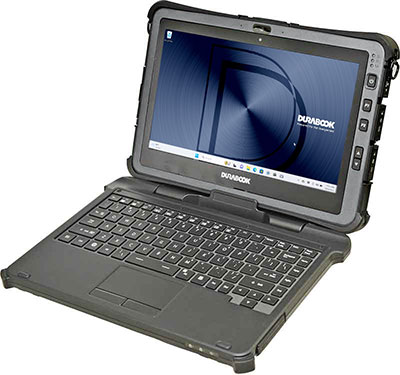
2-in-1 functionality — As tablets increasingly replace desktops and laptops in many deployments, "hybrid" functionality is more and more important. Durabook offers an excellent detachable keyboard for the U11. That's important when a tablet is also used in a field office for extended typing and data entry.
Connectivity — Consumer tablets often only have the barest minimum of ports. That won't do in a full-function enterprise Windows tablet. Durabook knows that and equipped the U11 with enough to cover all the bases. And that includes both state-of-the-art USB 3.2 and Thunderbolt 4 as well as optional legacy serial, PC Card and ExpressCard connectivity.
Ruggedness — The very reason the U11 exists is because it must be able to survive spills and drops and other calamities that kill consumer tablets. So it must be as tough as can be, and as well sealed as can be, but without looking like a tank and weighing a lot.
Performance — Intel has trained consumers to expect the latest chips and technology in a tablet. With a choice of two Intel 12th generation Core processors and related technology, the Durabook U11 has that, and is at the forefront of rugged tablet tech.
Touch and precision — Capacitive multi-touch is mandatory today, but it must work in challenging conditions. The U11 can handle fingers, gloves, stylus, and even a bit of rain. For precision work, there's an optional digitizer with an active pen that does not need a battery.
Security — Security is ever more important and a growing number of customers have specific security requirements for device usage. The U11 includes TPM 2.0, a very fast PCIe NVMe solid state disk that can quickly be removed from the outside, an insertable SmartCard/CAC reader, as well as Intel vPro, optional fingerprint scanner and contactless SmartCard/CAC reader.
Design, look, and feel — elegant utility
Below you can see the Durabook U11 from the front and all four sides. It's a clean, elegant and attractive design with a glass front, a dark-gray and black plastic and aluminum-magnesium alloy case, and protective black rubber bumpers. The bezel area around the display is wide enough to hold the tablet without inadvertently issuing a touch command, and except for the slightly protruding bumpers there is no border for fingers to bop into while operating the tablet.
The tablet is as solid as it looks. There is no flexing or twisting. The U11 has the trust-inspiring look of a reliable, well-conceived tool for the job.
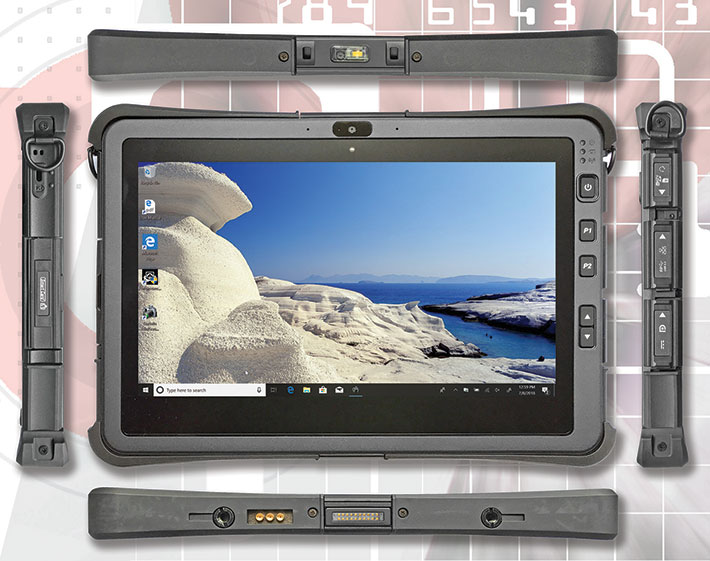
The front of the tablet shows a generous margin of flush black glass around the actual LCD. That's needed for optimal capacitive multi-touch operation. Along the right side of the tablet are five physical buttons: sleep/power, two programmable function keys, and up/down buttons that can be assigned either to brightness or volume.
The left side has a Kensington lock slot to physically secure the tablet and, in our unit, a slot to insert a SmartCard.
On the bottom is a surface-mount "Pogo" docking connector and, next to it, pass-through connectors for WLAN, GNSS and WWAN antennae. There are two metal mounting screw holes for use with the optional detachable keyboard.
Centered in the top is a configurable area that can accommodate a barcode scanner (shown), a RS232 serial port, or a USB-C port.
For space and sealing reasons, rugged tablets generally don't have much onboard wired connectivity, but the Durabook U11 does provide all the basics. The picture below shows the right side of the U11 (we removed all protective doors in this picture for better viewing).

From left to right, there's the power jack, a Thunderbolt 4 port, USB 3.2 Type-A, a RJ45 LAN jack, a microSD Card slot (supporting microSDHC and microSDXC cards), a SIM card slot, and an audio combo jack. The SIM and microSD Card openings have their separate protective cover that's screwed on.
A look inside — solid as a rock
Here at RuggedPCReview we're often asked why we take review machines apart. The answer is that ruggedness must be more than skin-deep. What it looks like inside — design, materials, manufacturing, quality — tells the real story. A truly rugged tablet must be designed rugged from the ground up, and inside out.
While from the front the U11 looks much like a consumer tablet with some extra hardware buttons and protective bumpers, on the back and inside this Durabook is all functionality and business. The battery, recessed into the backside of the tablet, can be replaced with a freshly charged on in seconds (and with the optional bridge battery, the battery becomes hot-swappable). Compare that with a consumer tablet battery that's inaccessible and glued in place.
The battery is part of the design and doesn't have a separate cover over it. A friction lever with a push button activator is used to securely hold the battery in place. It is unlikely that it'll ever work itself loose accidentally. A very clever design.
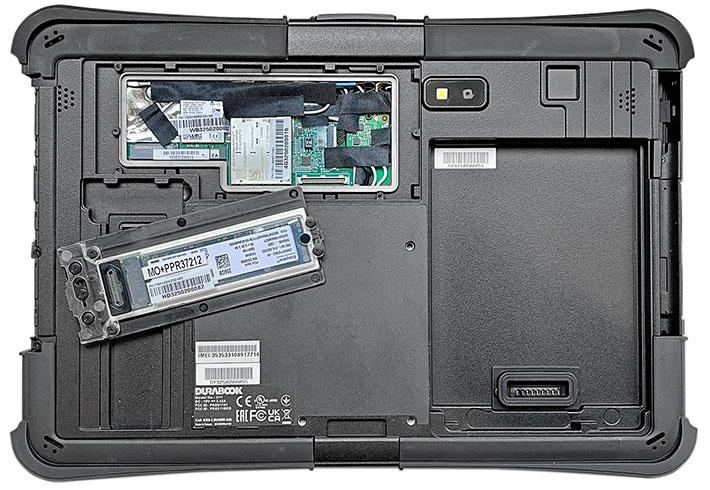
Since there is no battery compartment cover, the battery contact area has a rubber seal that presses against the aluminum-magnesium frame to make a watertight seal. Whenever replacing the battery, make sure the seal is fully intact. The slender (3/8-inch) battery itself is a Lithium-Ion design rated at 7.6 Volt, 4.5 Ahr, for a total of 36.5 watt-hours.
In the image above, note the tablet's solid state disk we placed on top of the partially disassembled backside of the Durabook U11, is a magnified view of the tablet's solid state disk. The storage module is encased in a separate caddy that snaps and locks into a recessed area of the U11 housing. This allows quick removal of the disk, something that is becoming mandatory in many applications.
The U11's expansion connector area is also externally accessible. It sits underneath a metal cover with a separate rubber seal. In our review unit, one of the the two half-size PCIe slots was occupied by an Intel Wi-Fi 6E AX211NGW M.2 module that also includes Bluetooth 5.3. The second PCIe slot can be used for an optional module such as the dedicated Ublox NEO-M9N GNSS. A full-size PCIe slot was occupied by an optional Sierra Wireless AirPrime EM7565 mobile broadband card with wire connections to the onboard antenna.
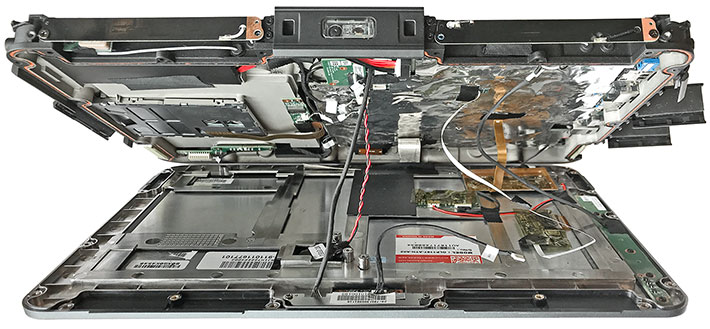
In terms of construction, the Durabook U11 employs a very sturdy aluminum-magnesium rear that serves as a chassis for most of the electronics, and a polymer plastic front. The two halves are secured together with about two dozen Philips head screws of various lengths. First remove the four protective corner bumpers that are really more than just corner guards; they also cover much of the sides of the tablet. The image above actually shows the prior version of the U11; since evals of the new model are in short supply, we didn't want to risk damaging our tester.
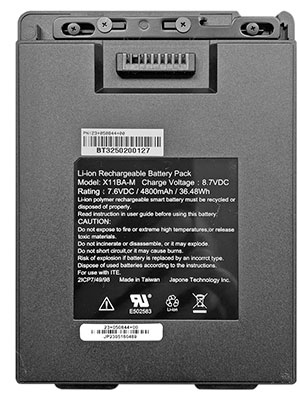 The sealing between the two halves is a tongue-and-groove design, with an orange sealing ring firmly sitting in the groove along the perimeter of the back part of the housing.
The sealing between the two halves is a tongue-and-groove design, with an orange sealing ring firmly sitting in the groove along the perimeter of the back part of the housing.
As a fanless design, the Durabook U11 doesn't have to worry about liquids getting inside through exhaust vents. The tablet's various wireless antennae, however, are placed outside of the sealed part of the housing for best possible performance. That means there are small holes with grommets for all the wires going to the antennae.
There are over half a dozen wires and ribbons between the two halves, connecting various boards and components. Some of the connections are delicate and not easily accessible, so care must be taken when disassembling the tablet completely.
What's often surprising when looking inside a rugged tablet is their great complexity compared to, say, an iPad. That's because Windows tablets are complete PCs with all of their modules and all of their settings and configuration options.
The U11 is no different. And, as a result, tablets like the U11 can be configured for the job at hand. Something that can't be said of consumer tablets. That said, we're not generally fans of too many wires, 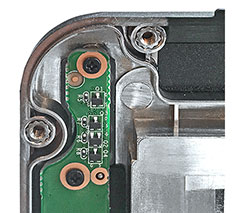 especially between halves of tablet housings, because each tiny connector is a potential source of failure.
especially between halves of tablet housings, because each tiny connector is a potential source of failure.
To the left and below are a couple of details that show what is involved in sealing such a complex piece of electronics to the elements, and to liquids in particular. The U11 is IP66 (up from IP65 in the prior version) sealed, where the "5" means it is now protected even against strong jets of water without leaking. That requires some pretty good seals.
But that's not all there is to sealing. If you use a metal case, as the U11 does, internal antennae will not work well because the metal shields them. For optimal reception, antennae must be outside the metal case. Durabook Americas did that by placing all antennae in cutouts along the perimeter of the housing.
This meant the seal had to meander around those cutouts. While they did that, they decided the placement of the screws that keep the two halves of the housing together should also be outside the seal. Good logic, difficult to manufacture, but Durabook Americas did it.

The U11's passive thermal management means there is no fan that can spin faster when there's a lot of processing load, or if the unit is operating in high ambient temperatures. In the test lab we used our FLIR One IR thermal imaging camera to see heat flows and heat dissipation. The images below show the U11's thermal signature while it was running the demanding PCMark10 benchmark. Peak temperatures remained amazingly low, with the hottest spot barely reaching over 90F. That's excellent. On fan-based designs we routinely see exhaust temperatures around 110F, and on fanless systems we've recorded over 120F. Durabook did an excellent job with its Coolfinity passive cooling tech.
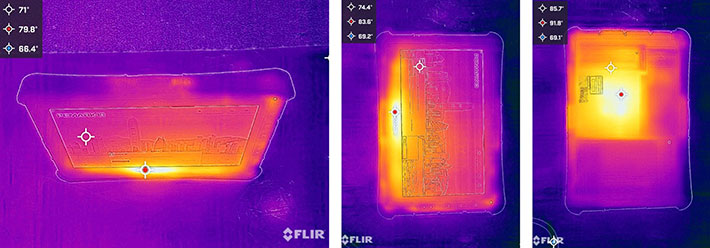
Intel "Alder Lake" 12th generation Core processor performance
When Durabook initially announced the latest version of the U11's fan-cooled R11 sistership on July 26, 2022, it was the first fully rugged tablet available with Intel "Alder Lake" 12th generation Core processors. In the hyper-competitive market for state-of-the-art rugged laptops and tablets, being first to market with new technology can sway purchase decisions and give a company an edge and competitive advantage. The U11's update to Alder Lake was announced a year later, in July 2023 (the R11 came first because it had been several Intel chip generations behind, whereas the U11 was still quite up-to-date with 10th generation tech).
|
2023 Durabook U11: Processor Options
|
|
Available Durabook U11 CPUs
|
Intel Core i5
|
Intel Core i7
|
|
Model
|
1230U
|
1250U
|
|
Model Code
|
12th gen Alder Lake
|
12th gen Alder Lake
|
|
Lithography
|
Intel 7
|
Intel 7
|
|
Performance cores
|
2
|
2
|
|
Efficient cores
|
8
|
8
|
|
Max turbo speed
|
3.30/4.40 GHz
|
3.50/4.70 GHz
|
|
Thermal Design Power (TDP)
|
9/29 watts
|
9/29 watts
|
|
Smart Cache
|
12MB
|
12MB
|
|
Integrated graphics
|
Intel Iris Xe
|
Intel Iris Xe
|
|
Execution Units
|
80
|
96
|
|
Graphics max speed
|
0.85 GHz
|
0.95 GHz
|
Note that Alder Lake is more than just another Intel chip generation. It is Intel's first major "hybrid" processor design, combining large, powerful performance cores ("p-cores") and smaller, simpler economy cores ("e-cores"). Why using two types? Because it's not energy-efficient to use high-performance cores for routine or background work. Smartphones, both on the iPhone and the Android side, have been using different cores for different work for years.
So with "Alder Lake," Intel brings, for the first time, combinations of p-cores and e-cores into its processors. For the p-cores, Intel used a new high-end microarchitecture called Golden Cove for a nice average 18% performance boost over comparable cores in the prior generation of Core processors. On the e-core side it is basically frugal Intel Atom processor technology, also with a new microarchitecture named Gracemont. According to Intel, each Gracemont e-core is capable of as much or more performance than one of Intel's 6th generation "Skylake" cores, at much lower power consumption.
How does the combination of p-cores and e-cores work? The concept is to route heavy-duty, time-critical work to the p-cores and simpler tasks of lesser importance to e-cores.  To make that work, Intel and Microsoft cooperatively created "Thread Director," a technology that continuously analyzes the processing workload and determines what goes to which type of core. Only Windows 11 includes full the thread director capabilities, which is why Alder Lake-based computers pretty much need Windows 11 to get the full benefit of this new hybrid CPU architecture.
To make that work, Intel and Microsoft cooperatively created "Thread Director," a technology that continuously analyzes the processing workload and determines what goes to which type of core. Only Windows 11 includes full the thread director capabilities, which is why Alder Lake-based computers pretty much need Windows 11 to get the full benefit of this new hybrid CPU architecture.
How all of this thread directing works goes well beyond the scope of this review (see RuggedPCReview's more detailed explanation here). The underlying concept is sound, as has been shown in literally billions of smartphones equipped with such hybrid chips. In essence, the U11 platform's jump from 10th to 12th generation Intel chips means going from four general purpose cores to two power cores and eight efficiency cores.
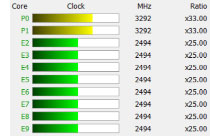 Durabook U11 customers have their choice of either a Core i5-1230U or a Core i7-1250U processor. Both have two dual-threaded p-cores and eight single-threaded e-cores. The difference between the two seems minor, with the i7-1250U running at slightly higher clock speeds and having 96 graphics execution units compared to the i5-1230U that must make do with 80 graphics execution units. The graph to the right shows the different behavior of the two p-cores compared to the eight e-cores while running a benchmark.
Durabook U11 customers have their choice of either a Core i5-1230U or a Core i7-1250U processor. Both have two dual-threaded p-cores and eight single-threaded e-cores. The difference between the two seems minor, with the i7-1250U running at slightly higher clock speeds and having 96 graphics execution units compared to the i5-1230U that must make do with 80 graphics execution units. The graph to the right shows the different behavior of the two p-cores compared to the eight e-cores while running a benchmark.
Do note that while both the Durabook U11 and R11 rugged tablets come with U-Series "Alder Lake" processors, the two available for the fanless U11 are from the 9/29 watt U-Series and those for the fan-based R11 from the 15/55 watt U-Series. More watts equals more power, but also more heat generated.
To see what kind of performance the Durabook U11 provides with the Core i5-1230U processor our evaluation unit came with, we ran our standard benchmark suites, Passmark Software's PerformanceTest version 6.1 and 9.0, PCMark 10, 3DMark, GeekBench 5, as well CrystalMark for confirmation and single core performance information.
The table shows how the updated Durabook U11 compares to other available "big-screen" (around 12-inch diagonal displays) rugged tablets, those being the predecessor version of the U11, the Durabook R11, the Durabook U11, the Dell 7230, the Getac F110 and K120, and the 12-inch version of the Zebra ET85:
|
Durabook U11 vs 12-inch class rugged tablets
|
|
Company
|
Durabook
|
Durabook
|
Durabook
|
Dell
|
Getac
|
Getac
|
Zebra
|
|
Model
|
U11
|
R11
|
U11
|
7230
|
F110
|
K120
|
ET85
|
|
Introduced
|
2023
|
2022
|
2020
|
2022
|
2021
|
2021
|
2022
|
|
CPU model
|
i5-1230U
|
i7-1255U
|
i5-10201Y
|
i5-1240U
|
i7-1165G7
|
i7-1165G7
|
i5-1130G7
|
|
CPU code
|
Alder Lake
|
Alder Lake
|
Comet Lake
|
Alder Lake
|
Tiger Lake
|
Tiger Lake
|
Tiger Lake
|
|
TDP
|
9/29 watts
|
15/55 watts
|
5.5/9 watts
|
9/29 watts
|
12/28 watts
|
12/28 watts
|
7/15 watts
|
|
Cooling
|
fanless
|
fan
|
fanless
|
fan
|
fan
|
fan
|
fan
|
|
Display size
|
11.6-inch
|
11.6-inch
|
11.6-inch
|
12.0-inch
|
11.6-inch
|
12.5-inch
|
12.0-inch
|
|
Resolution
|
1920 x 1080
|
1920 x 1080
|
1920 x 1080
|
1920 x 1200
|
1920 x 1080
|
1920 x 1080
|
2160 x 1440
|
|
Luminance
|
1156 nits
|
1246 nits
|
1204 nits
|
1337 nits
|
950 nits
|
1115 nits
|
706 nits
|
|
Footprint
|
12.50 x 8.00
|
11.80 x 7.60
|
12.50 x 8.00
|
11.65 x 8.00
|
12.40 x 8.15
|
13.0 x 9.40
|
12.10 x 8.90
|
|
Thickness
|
0.94
|
0.78
|
0.94
|
0.94
|
0.98
|
0.94
|
0.6
|
|
Volume (cu-in)
|
94.0
|
69.9
|
94.0
|
87.6
|
99.9
|
114.9
|
64.6
|
|
Weight (lbs.)
|
2.99
|
2.73
|
3.05
|
2.76
|
3.35
|
3.75
|
2.80
|
|
Operating temp
|
-20° to 145° F
|
-6° to 122° F
|
-20° to 145° F
|
-20° to 145° F
|
-20° to 145° F
|
-20° to 145° F
|
-4° to 140° F
|
|
IP rating
|
IP66
|
IP66
|
IP65
|
IP65
|
IP66
|
IP66
|
IP65
|
|
PassMark 6.1
|
5,653
|
11,001
|
2,504
|
8,364
|
6,382
|
6,585
|
5,534
|
|
PassMark 9.0
|
4,207
|
5,602
|
2,467
|
5,516
|
5,634
|
5,839
|
4,120
|
|
CrystalMark
|
324,132
|
417,117
|
197,684
|
401,322
|
535,124
|
522,217
|
317,931
|
|
PCMark 10
|
3,976
|
5,359
|
NA
|
4,847
|
5,020
|
5,148
|
3,855
|
|
3DMark TimeSpy
|
977
|
1,384
|
NA
|
1,142
|
1,314
|
1,434
|
888
|
|
GeekBench 5 S
|
1,447
|
1,586
|
NA
|
1,496
|
1,480
|
1,531
|
1,291
|
|
GeekBench 5 M
|
4,304
|
5,747
|
NA
|
7,049
|
4,690
|
4,831
|
3,136
|
When looking at the overall results, it's immediately clear that the new Durabook U11 is clearly quicker than the last generation U11 running on the older Intel "Comet Lake" chips (both machines had the low-end processor option installed, so it's a fair comparison). The overall benchmark edge the new machine holds over the old one is 2.25x in PassMark 6.1, 1.71x in PassMark 9.0, and 1.64x in CrystalMark. That is very noticeable.
Comparing the Durabook U11 with the Durabook R11 we tested last year presents a different picture. The fan-cooled R11 with its high-end Core i7-1255U 15/55 watt processor clearly outscores the passive-cooled U11 with the low-end Core i5-1230U 9/29 watt chip. It's the performance price one pays by choosing to go fanless. There are pros and cons with everything.
Comparing the benchmark results of the new i5-1230U powered U11 with Dell's i5-1240U based 7230 tablet best shows the performance difference between running with passive cooling and running with an active fan that generates noise, potentially unwanted air streams, and, being a moving mechanical component, may become a potential point of failure.
The same general picture presents itself when comparing the 12th gen U11 with some of the test results from 11th gen competition. The U11 can outperform systems with low-end 11th gen chips installed, like the Zebra ET85, but clearly falls behind machines with 11th gen mid-range and high-end chips. It amounts to the same: foregoing the fan means running at a lower overall performance level. It's a simple matter of thermodynamics.
The table below came as a surprise. The Durabook U10 powered through the complex PCMark10 faster on battery (green bar) than plugged in (orange bar)! Almost all system we're testing run faster plugged in than on battery, sometimes significantly faster. That means that those systems perform well in the office, but often not nearly as well unplugged in the field. The U11, on the other hand, ran through all of our benchmarks pretty much the same whether plugged in or on battery. As it should be.
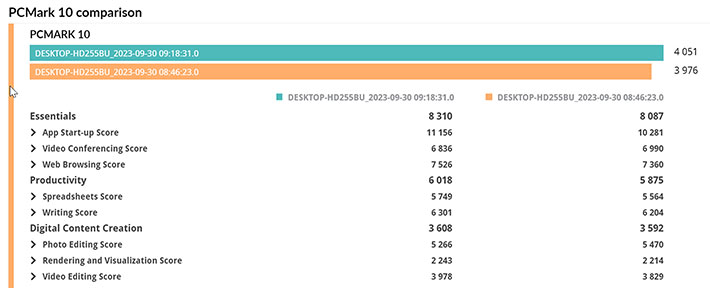
Overall, in our day-to-day testing, the Durabook U11 always felt quick and responsive, and easily handled any workload we threw at it. Also, do keep in mind that whereas U11 tablets with the Core i7-1250U installed will perform at a slightly higher level.
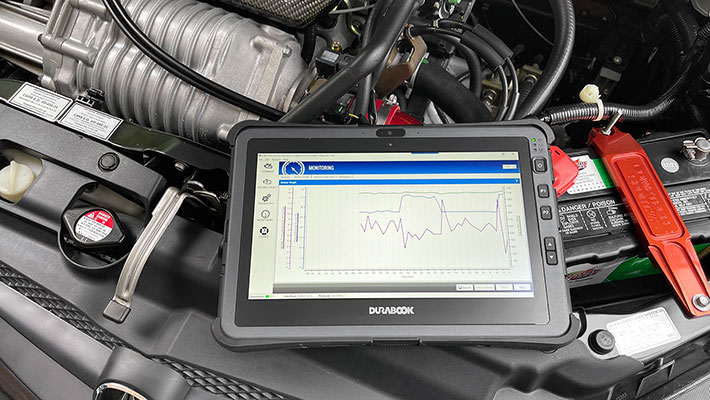
Battery life
Rugged laptops and tablets used to have very short battery life, which greatly limited the usefulness of mobile technology in the field. Battery technology has improved substantially, but not as quickly as processor and storage technology. As a result, it's still often a trade-off between size, weight, cost and battery life.
In 2010, the first iPad's 10 hour battery life redefined expectations of how long a tablet should last on a charge forever. 10 hours is a full shift plus another 25% to cover eventualities. The Durabook U11's spec sheet claims "10 hours." We presume, however, that the 10 hours is for the default display, whereas ours came with the optional 1000nits DynaVue sunlight readable display. Durabook indicated 20 hours with the optional 73 watt-hour battery, so we assume their claim would be 10 hours for the standard battery and the daylight screen.
|
Durabook U11 Power Draws (at idle)
|
|
Backlight level
|
Darkest
|
Recommended
|
Brightest
|
|
Max Battery
|
3.3 watts (11.1 hrs)
|
4.3 watts (8.5 hrs)
|
9.3 watts (3.9 hrs)
|
|
Max Performance
|
3.8 watts (9.6 hrs)
|
4.8 watts (7.6 hrs)
|
9.9 watts (3.7 hrs)
|
We used PassMark's BatteryMon to find out. With the Windows 11's power mode set to "Best power efficiency," screen brightness toggle set to its lowest setting, and the system in airplane mode, we saw a minimum of 3.8 watts. With the backlight set to 50% it was 4.8 watts, and with the backlight at 100% 9.3 watts. Dividing the full available 36.5 watt-hours of a fully charged battery by the lowest observed battery draw of 3.3 watts would indicate a theoretical battery life of 11.1 hours.
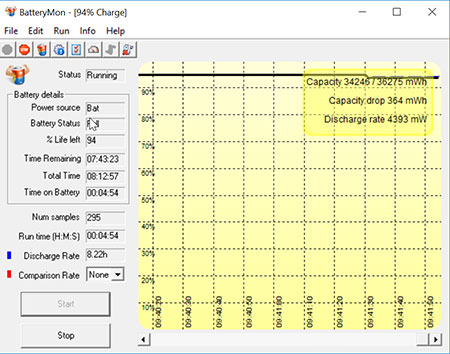 Putting the Windows 11 power mode to "Best performance," setting backlight to 0%, and airplane mode off, power draw was 3.8 watts, not much higher than in battery conservation mode. With the backlight set to the 50% level, it was 4.8 watts, and with the backlight at 100% it was 9.9 watts as in battery saver mode. This means that in "Best performance" mode and backlight as bright as Windows sets it, battery life drops to under four hours.
Putting the Windows 11 power mode to "Best performance," setting backlight to 0%, and airplane mode off, power draw was 3.8 watts, not much higher than in battery conservation mode. With the backlight set to the 50% level, it was 4.8 watts, and with the backlight at 100% it was 9.9 watts as in battery saver mode. This means that in "Best performance" mode and backlight as bright as Windows sets it, battery life drops to under four hours.
Measuring the lowest power draw with the system idling, of course, simply shows how long the computer can run doing nothing other than whatever background processes may be running. The other extreme is the PCMark 10 Battery test that continuously exercises the system with a variety of typical tasks, until the battery is fully run down. On that test, the U11 lasted 5:08 hours.
Bottomline: the Durabook U11 can theoretically last ten hours on a charge, just as the company claims. Continuous operation cuts that in half. Real life battery life, with the system going to sleep when not used, will be somewhere in between.
Increasing screen brightness to its highest level — and the U11 has a very bright screen — the small battery drains quickly. Which is why the the tablet has an optional bridge battery that allows hot-swapping (within five minutes) to a fully charged replacement battery. Or users can select the optional extended life 73 watt-hour battery that should bost theoretically achievable battery life all the way to 20 hours and probably boost real-world types of usage well beyond a full shift.
Excellent, spacious display
With a diagonal screen size of 11.6 inches, the U11 offers a generous amount of display real estate — almost a third more than that of a classic iPad, and almost three times as much as a typical 7-inch tablet. For a Windows 11 tablet suitable size is important, and especially so when wearing gloves or using apps with small controls. The FHD 1920 x 1080 pixel resolution is well-suited for this size display. The screen's 10-point capacitive multi-touch works fluidly and effortlessly, though we still appreciate the optional active digitizer for when you need more precision than a finger touch provides.
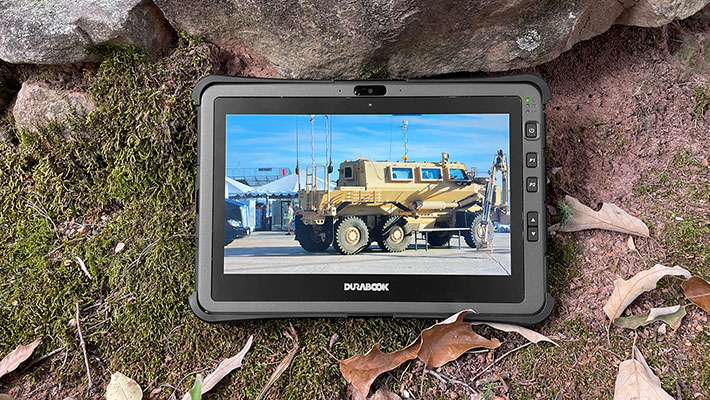
Like the Durabook R11 display, the U11's comes in a standard and a sunlight-readable version (which our review unit had). The latter uses optical bonding to reduce internal reflectivity and increase contrast, and a much stronger 1,000 nits backlight. 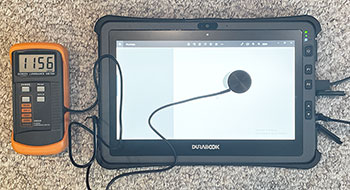 Any strong backlight, of course, draws a lot of power when fully cranked up, and so the U11 can use its light sensor to automatically adjust screen brightness, with settings configurable via a brightness level setup panel.
Any strong backlight, of course, draws a lot of power when fully cranked up, and so the U11 can use its light sensor to automatically adjust screen brightness, with settings configurable via a brightness level setup panel.
A few words about screen brightness here: A standard notebook backlight is in the 250 nits luminance range (1 nit = 1 candela per square meter) range. Some manufacturers up the brightness in their rugged products, usually into the 300-400 nits range. Industrial monitors used outdoors generally have 400 to 500 nits. High end rugged notebooks tablets offer anywhere from 500 to well over 1,000 nits. What this means is that the 1,000 nits backlight of the U11 is brighter than almost all consumer tablets and much brighter than any consumer notebook. In our testing, the U11 actually scored peak luminance of 1156 nits, significantly higher than its 1000 nits rating.
Luminance, however, isn't everything. Viewability, especially outdoors, also repends on display type and design, and on the various bonding and filter methods manufacturers apply to their displays. Durabook calls its tech DynaVue. The U11 display is what we'd call semi-matte, unlike the "glossy" displays prevalent in most consumer tablets and laptops. "Glossy" surfaces make colors "pop," but that comes at the cost of substantial reflections outdoors.
The pictures below show the U11 in full daylight outdoors. Unlike glossy displays, the U11 screen shows virtually no reflections at all. It's inherent in all matte display technologies that they diffuse light to some degree. Depending on lighting conditions, that can result in diminished perceived display brightness when looking at it from an angle.
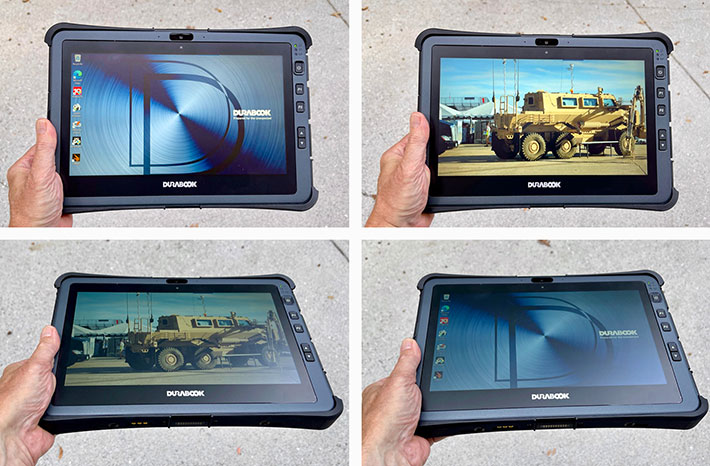
This diminished perceived brightness should not be confused with the brightness, contrast and color changes due to limited viewing angles. The U11's viewing angles are pretty much perfect both vertically and horizontally. We consider perfect viewing angles to be very important in tablets, and the U11 excel in that area. And a final plus of the U11 display: it's far more immune to fingerprints than most displays (and especially the glossy ones).
Capacitive multi-touch
As mentioned in the introduction, the Durabook U11 comes with capacitive multi-touch. This means that a generation of users that expects the effortless tapping, panning, pinching and zooming they're used to from their smartphones and consumer tablets will find just that on the U11.
That said, always keep in mind that, long ago, the Microsoft Windows Tablet PC Edition was originally designed to work best with an active pen that enabled "hovering" over selections, with the digitizer sensing the tip of the pen without the user actually touching the surface. That's still the case, and capacitive multi touch has never been a natural for Windows.
Before Windows 10 and now 11, all those tiny check boxes and scrollers and pull-downs that were designed for use with a mouse made operation via touch alone quite frustrating. Windows 10/11 have made steady improvements in touch friendliness, making the precision of an active pen with a very fine tip no longer as necessary as before. Below you can see the passive pen with 3mm tip on top and the optional Wacom-style active pen, which does not need a battery, on the bottom.

Windows-based tablets were late in adopting capacitive touch because the technology initially didn't work with gloves on or when things got wet. I say "initially" because capacitive touch technology has advanced to a point where most devices designed for outdoor work support gloves up to a certain thickness, and they can also be made to work in the rain.
 On the Durabook U11, users can select from four touch modes: finger/water, glove, and stylus (see image to the right). Finger/water is the default, "glove" reconfigures sensitivity to allow use with certain gloves, and "stylus" optimizes operation for the pen by ignoring unwanted finger touches when the pen already touches the surface. This goes a long way toward making capacitive multi touch work on a rugged Windows tablet.
On the Durabook U11, users can select from four touch modes: finger/water, glove, and stylus (see image to the right). Finger/water is the default, "glove" reconfigures sensitivity to allow use with certain gloves, and "stylus" optimizes operation for the pen by ignoring unwanted finger touches when the pen already touches the surface. This goes a long way toward making capacitive multi touch work on a rugged Windows tablet.
Impressive ruggedness
Durabook Americas' idea with the U11 was to provide customers a more rugged alternative to the existing Durabook R11. The goal was to make that happen without adding undue bulk and weight. As is, the U11 is a little thicker (0.94 vs 0.78 inches), a little heavier (2.99 vs 2.65 lbs.), and it has a noticeably smaller battery (36.5 vs 45.8 watt-hours). So extra ruggedness does come at a price. How much tougher is the U11 than the R11?
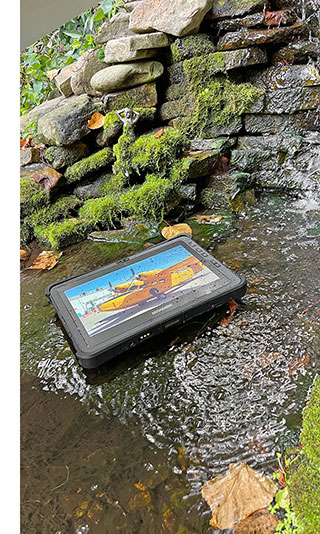 All ruggedness testing is conducted in accordance with procedures described in MIL-STD-810H. Durabook claims the U11 can handle repeated drops from six feet versus four feet for the R11. Being able to survive four-foot drops is important because that is roughly the height the tablet would fall if it slipped out of the hands of someone operating it in a standing position. Boosting that to six feet adds a potentially crucial safety margin and a lot of peace of mind.
All ruggedness testing is conducted in accordance with procedures described in MIL-STD-810H. Durabook claims the U11 can handle repeated drops from six feet versus four feet for the R11. Being able to survive four-foot drops is important because that is roughly the height the tablet would fall if it slipped out of the hands of someone operating it in a standing position. Boosting that to six feet adds a potentially crucial safety margin and a lot of peace of mind.
Durabook Americas also states shock and vibration resistance in testing similar to MIL-STD-810G, Method 514.6, Procedure I, Category 24, Fig 514.6E-1 which vibrates the unit while it is powered on at prescribed frequencies for an hour per axis. This test does not simulate an application environment, but rather suggests that a device that can pass that test will survive in the field. That's perhaps a bit vague and difficult to comprehend, but that's the supplied data.
On the sealing front, this latest U11 is at the IP65-level of ingress protection, higher than the IP65 protection of the predecessor model. The "6" means complete protection against dust, and the "6" means protection against strong jets of water jets from all directions. What that means, is that the new U11 can't only handle any degree of rain, but it can also be hosed down.
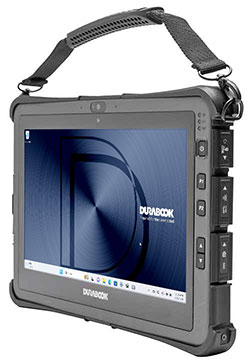 The operating temperature range is given as -4 to 140 degrees Fahrenheit (-20 to 60 centigrade). That's good enough for virtually all conceivable operating environments, including commercial freezers.
The operating temperature range is given as -4 to 140 degrees Fahrenheit (-20 to 60 centigrade). That's good enough for virtually all conceivable operating environments, including commercial freezers.
Do note that Twinhead, Durabook Americas' corporate mothership in Taiwan, has decades worth of experience making all sorts of rugged computers. Twinhead is who made all those rugged and ultra-rugged Itronix notebooks, and Twinhead is a major rugged equipment OEM to a lot of system integrators and resellers around the globe. They absolutely know what they're doing.
Apart from the given specs, our detailed examination of the U11 revealed an exceptionally sturdy design and construction. The very strong and rigid magnesium-aluminum backside/chassis keeps the unit from flexing, which guards against display breakage and eliminates most of the potential trouble spots in lesser units. Further protection is provided by the easily replaceable corner/side screw-on bumpers. Since the bumpers are screw-on designs, Durabook could easily offer larger ones for even more protection.
IP66 sealing against the elements is very effective, especially with the clever glide/lock design of the U11's protective port covers (which, of course, must be firmly in place and all seals must be undamaged in order to provide that protection).
And of importance for an increasing number of applications: the U11 is optionally available with ANSI/UL 121201 Class I, Division 2 protection, which means it can be used in environments where hazardous gases or vapors may exist but are not typically present in normal operating conditions, but there is a chance they might exist under abnormal conditions, like equipment failure.
Summary: The Durabook U11
With smartphones getting ever larger, tablet screens are growing, too. The 11.6-inch display size is a sweet spot for Microsoft Windows-based tablets — not too small and not too large. Newly upgraded to Intel "Alder Lake" 12th generation of Core processors, the fully-rugged Durabook U11 is designed to handle even the toughest jobs in any environment.
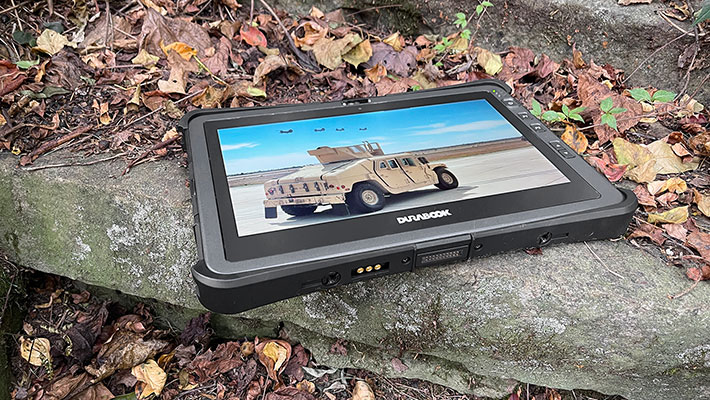
What sets the Durabook U11 apart from most competition is its fanless design that eliminates fan noise and unwanted air streams, and also eliminates the fan as a potentially troublesome piece of mechanical equipment that can get fail or get clogged.
The U11 has a satisfyingly large 11.6-inch display with 1920 x 1080 pixel resolution that's fully outdoor-viewable thanks to a strong backlight that provides 1000 nits luminance. The capacitive multi-touch screen is quick and responsive and has settings for wetness, gloves, and stylus. An active (batteryless) pen option is for those who like to draw or annotate, or need extra precision.
The Durabook U11 combines a sleek, elegant design and manageable weight of just under three pounds with remarkable ruggedness. Thanks to a magnesium-aluminum alloy build and well designed protected (and replaceable) bumpers and port covers, the Durabook U11 is fully dustproof and can handle any amount of rain and even jets of water. It also can be used in an exceptionally wide temperature range.
Contemporary security requirements are with addressed both in software (TPM 2.0, Windows, BIOS) and hardware (quick-release SSD, stealth/night vision modes, optional fingerprint scanner, contactless SmartCard/CAC, etc.)
Overall, the fanless Durabook U11 addresses many of the special requirements of markets such as public safety, oil & gas, the military, and any others that require a light, handy and exceptionally configurable high-performance Windows 11 tablet to tackle any job in the field.
– -- Conrad H. Blickenstorfer, October 2023
|
Durabook U11 2023 Specifications
|
| Status |
U11 fist introduced March 2018; added updated version of the U11 05/2020; full review updated original version: 05/2020; full review 2023 update: October 2023.
|
| Product type |
Fully-rugged tablet computer
|
| Processor
|
Intel Core i7-1250U, 12MB cache, up to 4.70GHz, 2P+8E cores
Intel Core i5-1230U, 12MB cache, up to 4.40GHz, 2P+8E cores
|
| CPU Thermal Design Power
|
Both 9 watts base power, 29 watts max turbo power
|
| OS
|
Windows 11 Professional |
| Graphics Controller/Chipset
|
Intel Iris Xe Graphics
|
| Memory
|
Onboard 8GB up to 32GB LPDDR4x in one slot
|
| Display type
|
TFT LCD with AG/AR film, optional sunlight-readable 1,000 nits display
|
| Display size and resolution
|
11.6" 1920 x 1080 pixel (190 ppi); optional 11000 nits DynaVue
|
| Digitizer/Pens
|
Capacitive multi-touch, glove-capable, optional Wacom-style digitizer with active batteryless pen
|
| Keyboard
|
Onscreen keyboard, optional detachable kbd with 2 USB ports
|
| Storage
|
256GB up to 2TB PCIe NVMe SSD; optional OPAL 2.0 SSD |
| Multimedia Pocket
|
NA |
| Slots
|
1 x micro-SDXC, 1 x Nano SIM card, optional expansion modules (PCMCIA type II OR ExpressCard 54 OR LF/HF-RFID (NFC) OR 2nd smart card reader)
|
| Housing
|
Aluminum-magnesium chassis |
| Temperature
|
-4° to 140°F (-20° to 60°F) |
| Humidity
|
MIL-STD-810H |
| Vibration
|
MIL-STD-810H |
| Enclosure Class
|
IP66 |
| EMI
|
MIL-STD-461G |
| Shock: Transit Drop
|
6 feet 26 faces |
| Intrinsic safety
|
Optional Class I, Division 2, Groups A, B, C, D, T Code T5 |
| Size (inches)
|
12.5 x 8.5 x 0.94 inches (318 x 216 x 24 mm) |
| Weight
|
Starting at 3.0 lbs. (1.35 kg.)
|
| Power
|
7.6 Volt, 4,800mAH, 36.5 watt-hour Li-Polymer ("10 hrs"), bridge battery; optional 7.6 Volt, 9,600mAH, 73 watt-hour hi-cap battery ("20 hrs"), optional bridge battery (5 minutes) |
| Camera
|
2.0mp front-facing, optional 8mp rear-facing auto-focus with flash and geo-tagging; optional IR camera for Windows Hello face authentication |
| Wireless
|
Intel Wi-Fi 6E AX211 (802.11ax) with Bluetooth 5.3; optional: 4G LTE multi-carrier; 5G (project-based); dedicated Ublox NEO-M9N GNSS module; RF antenna pass-through for GPS, WWAN, and WLAN; 1D/2D barcode reader
|
| Security
|
Kensington Lock, TPM 2.0, user removable SSD, Intel vPro;. optional fingerprint scanner, smart card reader, Windows Hello, NFC reader, night vision mode
|
| Audio
|
Integrated microphone, dual speakers, Intel HD Audio compliant
|
| Interface
|
1 x Thunderbolt 4, 1 x USB-A 3.2 Gen1, 1 x gigabit RJ45 LAN, 1 x DB9 RS232/422/485, audio in/out; optional: external RF antenna pass-through (WWAN, WLAN, GPS), USB-C 3.2 OR 2nd USB-A 3.2 OR USB-A 2.0 OR RS232 OR 1D/2D barcode reader
|
Price
|
Starting at $2,199
|
| Website
|
Durabook U11 |
| Brochure
|
 Durabook U11 (pdf) Durabook U11 (pdf)
|
| Warranty
|
3 years (includes accidental damage)
|
| Contact
|
Durabook Americas, https://www.durabookamericas.com, 1-510-492-0828.
|






